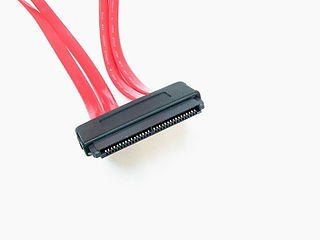| SCSI architectural model |
|---|
| SCSI Application Layer |
| SAL |
| SCSI Transport Protocol Layer |
| STPL |
| SCSI Interconnect Layer |
| SIL |
The SCSI architectural model provides an abstract view of the way that SCSI devices communicate. It is intended to show how the different SCSI standards are inter-related. The main concepts and terminology of the SCSI architectural model are:

Small Computer System Interface is a set of standards for physically connecting and transferring data between computers and peripheral devices. The SCSI standards define commands, protocols, electrical, optical and logical interfaces. SCSI is most commonly used for hard disk drives and tape drives, but it can connect a wide range of other devices, including scanners and CD drives, although not all controllers can handle all devices. The SCSI standard defines command sets for specific peripheral device types; the presence of "unknown" as one of these types means that in theory it can be used as an interface to almost any device, but the standard is highly pragmatic and addressed toward commercial requirements.
- Only the externally observable behavior is defined in SCSI standards.
- The relationship between SCSI devices is described by a client-server service-delivery model. The client is called a SCSI initiator and the server is called a SCSI target.
- A SCSI domain consists of at least one SCSI device, at least one SCSI target and at least one SCSI initiator interconnected by a service delivery subsystem.
- A SCSI device has one or more SCSI ports, and a SCSI port may have an optional SCSI port identifier (SCSI ID or PID).
- A SCSI device can have an optional SCSI device name which must be unique within the SCSI domain in which the SCSI device has SCSI ports. This is often called a World Wide Name. Note that the "world" may only consist of a very small number of SCSI devices.
- A SCSI target consists of one or more logical units (LUNs), which are identified by logical unit numbers.
- A LUN may have dependent LUNs embedded within it. This can recur up to a maximum nesting depth of four addressable levels.
- There are three type of SCSI ports: initiator ports, target ports and target/initiator ports. A SCSI device may contain any combination of initiator ports, target ports and target/initiator ports.
- SCSI distributed objects are considered to communicate in a three layer model:
- The highest level of abstraction is the SCSI Application Layer (SAL) where an initiator and a target are considered to communicate using SCSI commands sent via the SCSI application protocol.
- The SCSI Transport Protocol Layer (STPL) is where an initiator and a target are considered to communicate using a SCSI transport protocol. Examples of SCSI transport protocols are Fibre Channel, SSA, SAS, UAS, iSCSI and the SCSI Parallel Interface.
- The lowest level is the SCSI Interconnect Layer (SIL) where an initiator and a target are considered to communicate using an interconnect. It consists of the services, signaling mechanism and interconnect subsystem used for the physical transfer of data from an initiator to a target.
Fibre Channel (FC) is a high-speed data transfer protocol providing in-order, lossless delivery of raw block data, primarily used to connect computer data storage to servers. Fibre Channel is mainly used in storage area networks (SAN) in commercial data centers. Fibre Channel networks form a switched fabric because they operate in unison as one big switch. Fibre Channel typically runs on optical fiber cables within and between data centers, but can also run on copper cabling.
Serial Storage Architecture (SSA) was a serial transport protocol used to attach disk drives to server computers.
USB Attached SCSI (UAS) or USB Attached SCSI Protocol (UASP) is a computer protocol used to move data to and from USB storage devices such as hard drives (HDDs), solid-state drives (SSDs), and thumb drives. UAS depends on the USB protocol, and uses the standard SCSI command set. Use of UAS generally provides faster transfers compared to the older USB Mass Storage Bulk-Only Transport (BOT) drivers.
- A SCSI task is represented by an I_T_L_Q nexus. This is where one Initiator Port talks to one Target Port, addressing one LUN and together they execute one task (identified by Q).
A World Wide Name (WWN) or World Wide Identifier (WWID) is a unique identifier used in storage technologies including Fibre Channel, Advanced Technology Attachment (ATA) or Serial Attached SCSI (SAS).
In computer storage, a logical unit number, or LUN, is a number used to identify a logical unit, which is a device addressed by the SCSI protocol or Storage Area Network protocols which encapsulate SCSI, such as Fibre Channel or iSCSI.
In SCSI computer storage, computers and storage devices use a client-server model of communication. The computer is a client which requests the storage device to perform a service, e.g., to read or write data. The SCSI command architecture was originally defined for parallel SCSI buses but has been carried forward with minimal change for use with Fibre Channel, iSCSI, Serial Attached SCSI, and other transport layers.






